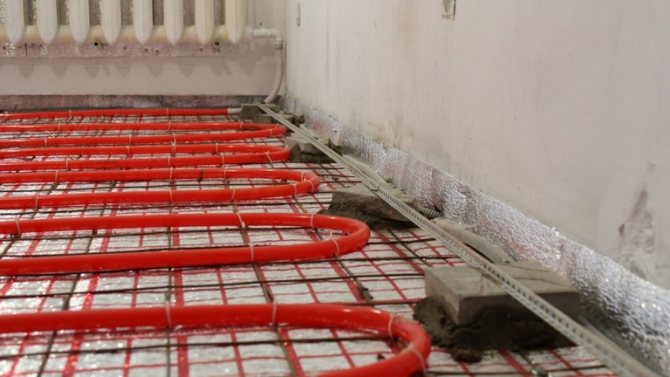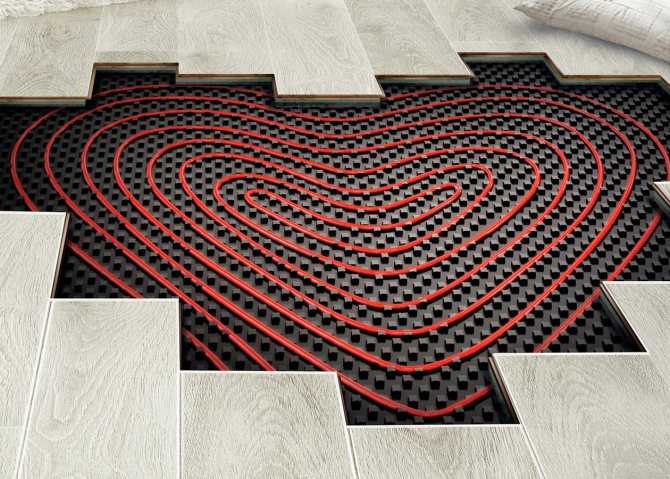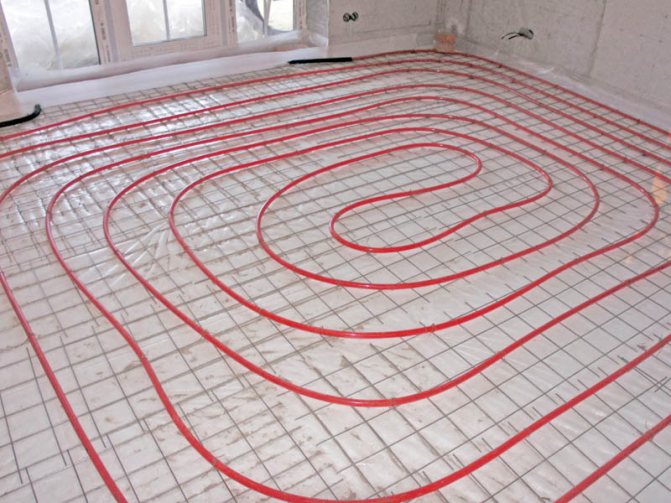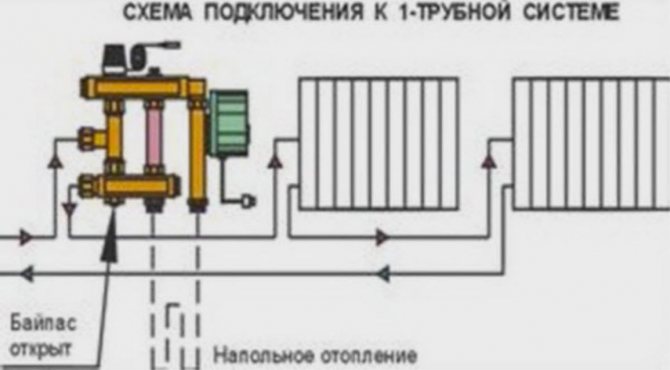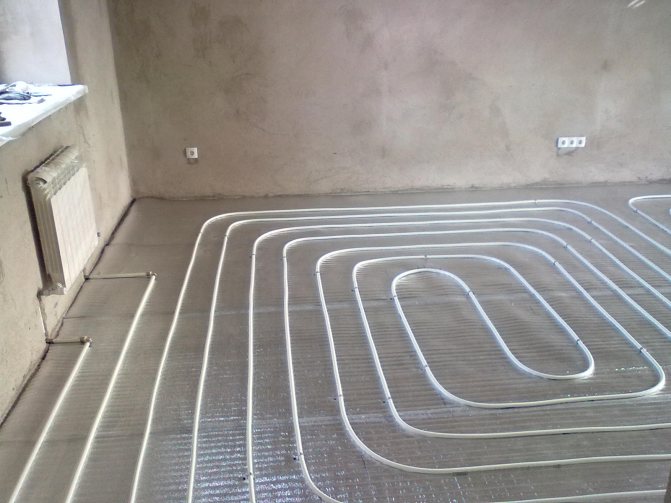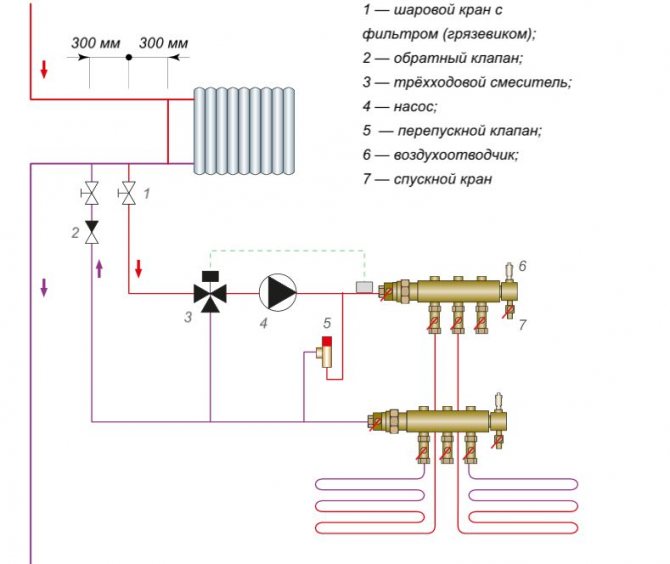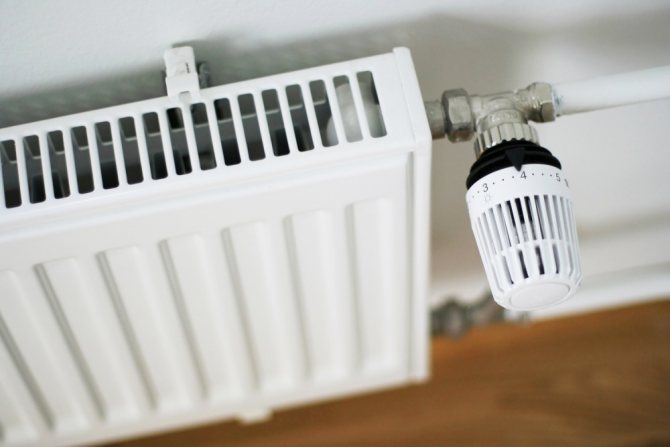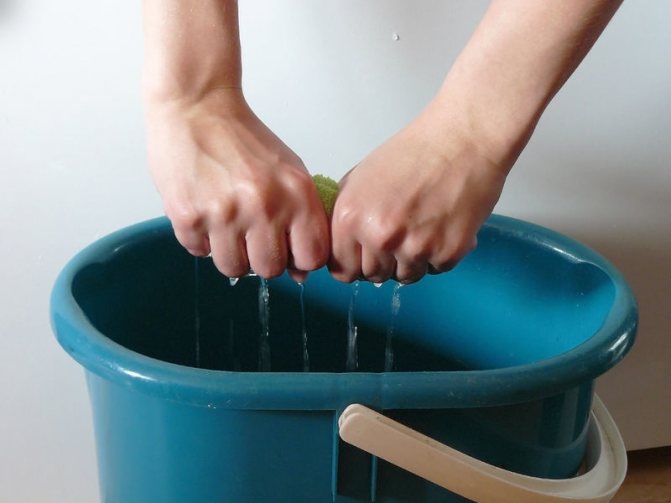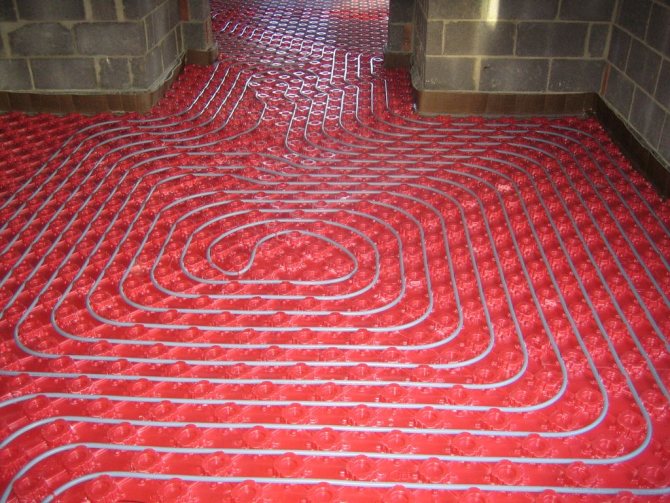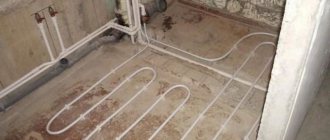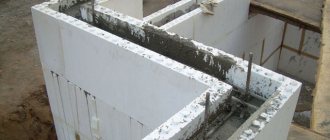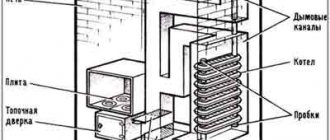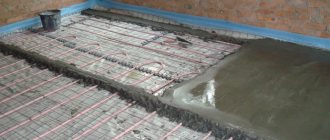Warm floors from central heating in the apartment fine
However, apartment owners have to face a number of problems when laying this type of heating. First of all, it is necessary to inform the management company of the house about your desire to carry out additional heating. A special permit for the installation of underfloor heating is issued by this very administrative body. Illegal bumping into central heating is being tracked.
If a violation is found, heavy fines are imposed. It is possible to make a warm floor only with the consent of the administration of the house.
It is very difficult to obtain this document. The consent of the parties depends on many factors.
The central heating system is calculated without a large margin for unauthorized connections.
If this is only one apartment, then this will not affect the consumption and overall operation of the heating. But there are many who want to connect a warm floor in a multi-storey building.
In this regard, there is a threat of failure of the entire central highway.
Output
Considering that most of the apartments have neighbors on all sides, and only the front wall goes out onto the street, it is safe to say that there is enough water floor heating for the apartment with a margin. Radiators can be dispensed with. Water underfloor heating is a low-temperature heating system. Just in most residential buildings, the temperature regime is not observed. For example, radiators are designed to supply 75 degrees, but in fact 60 degrees come in, respectively, the device cannot give off the required amount of heat. A water-heated floor allows you to compensate for such a drawback, because 35 -40C will be enough for it to supply. Due to its area, it is able to warm up almost any room in a multi-storey building. In corner apartments, residents try to add a radiator to the cold wall of the house. This is a point-to-point solution. Underfloor heating pipes allow you to cut off the cold along the entire length of the wall. Such a solution will allow you to put the cabinet against a cold wall. A water heat-insulated floor in an apartment with stained-glass windows is an ideal solution. By installing automatic heads on the water floor collector, and thermostats in the rooms, you can achieve the ideal microclimate for each room.
Read more Duties of a single heat supply organization
Self-installation of a water-heated floor in an apartment
Therefore, before arranging a water-heated floor in an apartment with your own hands or with the help of involved builders, you must first calculate all the advantages and disadvantages of the solution, take into account the possible risks and negative consequences. representatives of housing and communal services and heating systems.
In practice, this is possible only in the case of autonomous heating provided for in the project documentation. There are three main disadvantages of a water-heated floor in an apartment:
- The consequences of possible leaks, the responsibility for which lies entirely with the owner of the apartment.
- Difficulties associated with registration and legalization of the work performed.
- Responsibility for inconsistent installation.
To install warm water floors, you will need to overcome all these difficulties. Decoration - reasons why in apartments
However, if underfloor heating is installed in an apartment located in a house with insufficient, problems remain. This category includes all houses, except for new buildings.
In the old days, houses were built with a power grid designed for the minimum number of electrical appliances, and the old wiring does not withstand the use of modern appliances, including the use of an electric floor.
For underfloor heating, it is necessary to replace the wiring and the distribution board. The housing inspectorate must provide a certificate of the power of the device, confirming that the warm floor will not cause overloads in the network.
Such a certificate will remove responsibility in case of any problems with the electrical network.
Harmonization
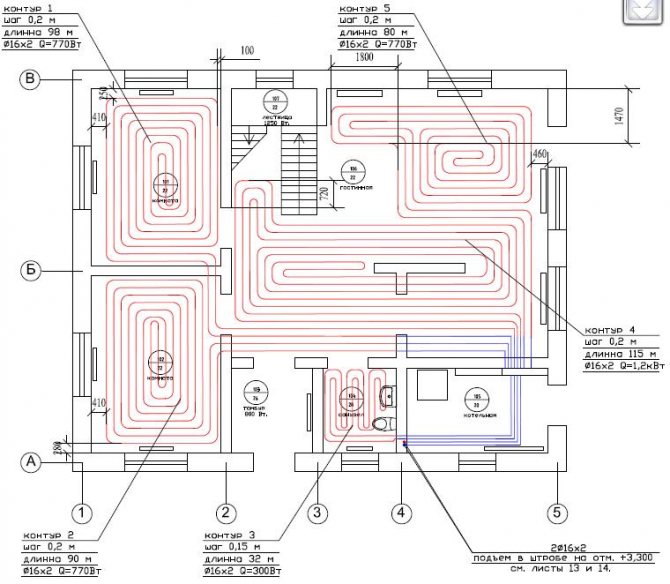
When a technical conclusion is received from the energy supervision or heating networks about the possibility of changing the floor contour, a project is made, which is then agreed upon in the housing inspectorate. To develop a project, you should contact a design organization that has an SRO approval.
After the installation of the floors, it is impossible to inspect the work, therefore the builders fill out the certificates of the survey of the hidden works. These workers must also have an SRO permit. The documents are signed by them and representatives of the design organization. The issued acts are entered into the work production log.
An organization that makes a warm floor in an apartment must be licensed. After the work, the heating operation of the system is tested. Based on the test results, an appropriate act is drawn up. For a water floor, a hydraulic test certificate is required, for an electrical one - an act of approbation of control and protection automation.
General list of documents that must be at the time of installation of the heating system:
- License from the construction organization performing the installation;
- Certificate of survey of hidden works and executive documentation for the installation of heating elements;
- Examination of hydraulic tests;
- Examination of thermal tests.
List of documents required for further operation:
- Drawings, as well as an act of their compliance with the work performed;
- certificate of inspection of hidden works;
- act of thermal testing of heating devices;
- an act of individual testing of automation of regulation and protection.
Everyone knows the delights of the comfort of a warm floor. But the price of a set of electric underfloor heating, and in the future, monthly bills for consumed electricity can somewhat overshadow the pleasure of such comfort. An excellent alternative is a water heat-insulated floor. If the house or apartment has autonomous heating - the practice is already widespread, experience can be gleaned in various articles, reviews. But what if the apartment is located in a multi-storey building with central heating? There is nothing to be done - you need to make a water heat-insulated floor from central heating.
Read more Under what conditions do you give an academic leave
A kitchen and a bathroom were chosen for this experiment. Ceramic tiles are very conducive to the warm floor, especially in winter. So where do you start?
Why is there a fine for underfloor heating?
And the connection by residents of an additional source of heat consumption leads to a decrease in the efficiency of the system.
Such a certificate must be obtained from the management company serving the house where this redevelopment is planned. If there is not enough power, the electric floor cannot be installed. New buildings have a significant power reserve, it is easier to legalize warm electric floors there.
In other words, some will be good, while others will not. Also, in the event of a breakthrough of communications in the floor, the neighbors below may suffer from flooding. And you will have to sort things out with them in court. The authorities constantly warn about the responsibility for installing the water circuit, but there are still people who want to install it in their apartment.
Since in our conditions it is almost impossible to obtain official permission for this, many act at their own peril and risk.
We recommend to read: Is it possible to put a car in a paid parking lot at night without paying
If no one finds out, then maybe it will be bypassed. The official design of an autonomous water heating system presupposes that at least two conditions are met: After installing the underfloor heating, the total power must remain unchanged. But for this it is necessary to reduce the number of heating batteries in the rooms, and this is not always acceptable.
Hot water floor heating with electric boiler
If you cannot get attached to the central heating system under any circumstances, you can use a small electric boiler. Of course, the cost of such heating will increase significantly, but
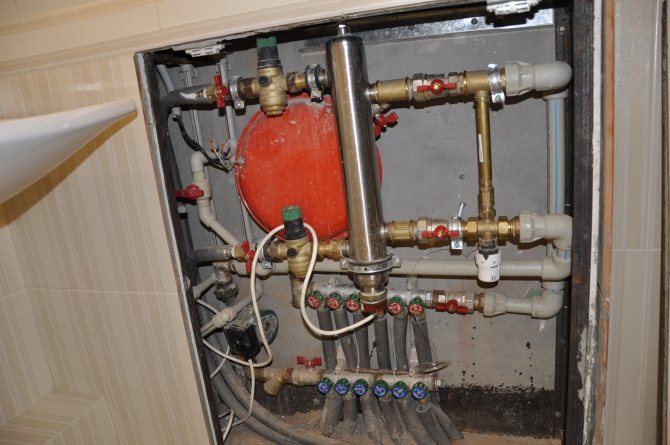

reliability will remain higher than that of electric ones. In case of cable burnout, you will have to open the entire cable tie to replace the cable. With electric floors, it is not always possible to change the arrangement of furniture. Water heated floors are not subject to overheating. Maintenance of an electric boiler is much easier and cheaper than replacing the cable in the floor screed. The photo shows an electric boiler for an apartment water floor, created on the basis of an ordinary electric heater for a water heater. The body is made of stainless steel pipe. Such a mini-boiler is easy to maintain, and tens are sold in any city and are always available.
The creation of a cozy and comfortable atmosphere in an apartment largely depends on the created microclimate. But in the conditions of a central heating system with radiator devices, it is problematic to achieve the necessary conditions. In private houses with autonomous heating, this situation is solved by installing a warm floor, but is it possible in an apartment?
Underfloor heating is effective due to uniform heating of the entire room. The system easily allows you to achieve the required microclimate even at the lowest temperatures outside the window. The issue of installing underfloor heating in apartments on the ground floors, as well as where small children live, is especially relevant.
The creation of additional circuits can create serious problems in heating, not only in a single apartment, but also in the entire residential building.
The main problems that can be encountered when installing floor heating:
- increased hydraulic resistance;
- return of the coolant to the riser with a lower temperature.
Such problems entail malfunctions in the operation of the heating system, as well as its failure.
It is forbidden to install underfloor heating in apartment buildings, where each room has its own riser. Installation of an additional circuit inevitably leads to a violation of the thermal balance in the house. Changes in heating will quickly be felt by neighbors.
Underfloor heating fines
Heating in the house is done according to the project, the flow rate of the coolant is calculated depending on the number of batteries, pipe diameters, on the materials of walls and floors, on the region where the house is located, and much more. Those. as much coolant is supplied to your house as provided by the project.
If you make a warm floor, you will take more coolant for yourself than the project provides, but exactly what is supposed to be supplied to the house, which means that you are taking heat from the neighbors. Hence the complaints of neighbors about the sudden drop in temperature in the apartments, followed by visits first by representatives of the ZhEK, then by the Housing Inspectorate, a fine, a court, a decision to bring everything that was put into the state that was before your intervention at your expense, of course.
Please note that in some cases, if your actions pose a danger to all residents of the house, they can knock the door into the apartment without your consent.
Underfloor heating from central heating in the apartment
If detected, the owner of the apartment faces an administrative fine.
Why underfloor heating from central heating is impractical: Inserting a warm floor into an existing system leads to a violation of the temperature balance of the entire riser.
If this happens on the upper floors, the "loss of degrees" may not be noticeable, but from the middle of the house it will become critical. Underfloor pipes are a potential risk of accidents.
If damaged, it will flood all downstream apartments. It will not work to get a high temperature of the coolant in the system, precisely because of the total supply to the riser.
In winter, such floors will be slightly warm, and during the off-season, when the heating has not yet been turned on or has already been turned off, there is no sense at all in such a system. The quality and purity of the coolant in the central pipeline has always left much to be desired. Since the maximum pipe diameter for TP does not exceed
Classic connection diagram
Underfloor heating from central heating implies the presence of the necessary equipment: a circulation pump, a collector group and temperature control sensors. The underfloor heating is connected before it is poured with cement. The diameter of the water heating pipes is taken into account, it should be 12-20 mm.
A water-heated floor in an apartment involves the following elements:
The heart of the whole circuit is the distribution unit, which is responsible for regulating the temperature of the coolant. The fact is that the temperature of the water in the supply pipes is very high. It must be cooled to an acceptable threshold - 30-35 °, otherwise the underfloor heating system will fail.
A key role in this design is played by a three-way valve, which is configured to distribute and control the temperature of the heating medium. The valve is accompanied by a special sensor, another name for a thermal head, which carries out thermoregulation using the position of the stem. This device allows the owner to set the required temperature and thereby save on heating.
The valve works very simply. When the set temperature threshold is exceeded, a special damper shuts off all or part of the hot flow. The presence of a three-way valve in the distribution unit is required.
Underfloor heating from central heating will not function without a circulation pump. Water will always find the path of least resistance, so a pump is installed to efficiently distribute the coolant. Its location is in front of the manifold group and after the distribution unit. The three-way valve supplies the already cooled coolant to the pump, then the working fluid enters the manifold for further distribution along the floor contours.
The collector group must necessarily include an air outlet and a drain valve. These elements are installed at the top (air outlet) and bottom (drain cock) points of the manifold.
Considering the fact that the working fluid is not clean, it is necessary to install mud filters. Thus, the service life of the water floor is extended. Dirty coolant will clog small pipes of the water floor very quickly.
This scheme is classic and works for apartments on the upper or lower floors, depending on the location of the common heat exchanger. If the apartment crashes into the middle floors, then the scheme has some deviations. For example, instead of a three-way valve, a two-way valve is used.
Installation of a warm water floor requires formal approval from the management company. It is possible to make a connection to a common line, but the established norms and rules for the installation and operation of equipment should be observed. Illegal entry into the central system is prohibited. This will entail the payment of large fines and the dismantling of the water heated floor.
What is the penalty for warm floors
And if the underfloor heating is planned from the mains, but the house has old wiring, the results will also be disastrous.
Is it possible to install underfloor heating legally There is no direct context, which would contain the amount of the fine for installing underfloor heating. However, there is an article stipulating responsibility for the redevelopment of the premises. In addition, there is a Resolution on the organization of reorganization - PPM 508-PP.
Instead of deliberately violating the law, it is better to try to legalize underfloor heating.
Moreover, it is quite possible, especially in new buildings.
Old buildings have very weak electrical wiring, designed for a small number of electrical appliances.
In order to obtain permission to install a floor heating system, you need to provide the following documents: To carry out an electric floor heating - a certificate on the power of the electrical network in the house and a document on what power the floor heating system will consume;
Warm floors from central heating in the apartment fine
If this system is discovered by competent services, then a large fine is possible. If you decide to install underfloor heating from central heating in an apartment, then you need to study all the available options.
In order to choose the most suitable option for your case. A connection where a direct connection diagram to a heating radiator is used. The most primitive low-power water pump is used.
The simplest and least expensive method, but has very low reliability.
With this method of connection, heating cannot be controlled, and the temperature in the system can drop significantly, which can lead to a disruption in the heat supply of other apartments powered by this riser.
Connecting a water underfloor heating to a radiator Direct connection using a bypass.
Recommended reading: If a grandmother is taking her grandson abroad
Installation of underfloor heating
Despite the limitations of utilities, even in the most difficult cases, an additional circuit can be created without creating problems in the heating system. To do this, it is necessary to create conditions for controlled heat consumption and maintain the balance of the coolant in the system.
To create an additional contour in the floor, consider the following points:
- Use reinforced-plastic pipes. They are able to withstand water hammer. Plastic pipes are ineffective in this case.
- For a warm floor, the optimum temperature is 30-40 C, but at the same time, the coolant in the batteries has an indicator of 70-90 C. To solve this problem, a water pump is mounted in the system.
- It is imperative to have a manifold cabinet, which will contain the necessary valves, connections and outlets.
- The installation of heat meters in the apartment will solve the problems with the flow rate of the heat carrier in the system.
Overview of basic circuits
The simplest scheme is with a pump
The simplest scheme of a warm water floor from central heating involves a direct connection to a radiator and a pump included in the system. The last one is picked up by the weakest.
The coolant flow rate should be up to 5-10 liters per minute. Such a scheme is the most unreliable, since there is no possible regulation of the circuit. The operation of underfloor heating in this case can lead to a decrease in heat transfer from radiators, as well as affect the batteries in neighboring apartments.
The circuit with the addition of a balancing valve allows you to adjust the level of floor heating.
Adding a balancing valve to the circuit
The creation of the circuit is quite simple, according to the principle of the previous one, but adding a tap to some extent solves the issue of heat imbalance in the system.
Reducing the heat consumption can be achieved by including a three-way mixing valve with a thermostat in the circuit. Underfloor heating from central heating in an apartment according to this scheme is also supplied with a pump and a balancing valve.
Such a system allows you to automatically regulate the temperature of the coolant. The required maximum temperature for the battery is set, a more cooled coolant enters the floors.
Underfloor heating from central heating without a pump can be installed in those apartments where there is one common riser, and not several.
For this, a mixing unit is installed in the circuit, and a flow regulator is installed at the inlet.The consumption of the heat carrier should be minimal, otherwise the neighboring apartments receive a reduced amount of water in the radiators. This situation entails fines from utilities.
The most optimal solution for an apartment is to connect underfloor heating through a heat exchanger. This option actually allows you to create your own closed circuit, to which only the temperature is transmitted.
The floor is not affected by pressure and costs. The heating medium from the central system does not enter the mixing unit. Such a scheme greatly simplifies control over the system.
In this case, underfloor heating from central heating does not affect the temperature in the radiators, both in your apartment and in neighboring ones.
Important nuances
It should be remembered that an incorrectly wired circuit can lead to serious consequences.
In most cases, utilities prohibit the installation of water floors in apartment buildings in order to avoid damage to the heating system.
The best option is to create warm floors powered by electricity. If a choice is made in favor of water heating, then it is worth taking care of a closed system, or using complex circuits with regulating devices.
We recommend that you look at one of the options for professional alteration of the central heating system. The video shows many important nuances and aspects.
We hope that the article was useful to you. We will be very grateful if you share it with your friends on social networks.
What is the penalty for warm floors
As soon as a new "participant" appears in the system, the load on all heating points changes.
If you think about a possible accident in the underfloor heating system, you can imagine the scale of the disaster for your neighbors.
And if the underfloor heating is planned from the mains, but the house has old wiring, the results will also be disastrous. There is no direct context where the amount of the fine for installing a warm floor would be contained in the legislation.
However, there is an article stipulating responsibility for the redevelopment of the premises. In addition, there is a Resolution on the organization of reorganization - PPM 508-PP. Instead of deliberately violating the law, it is better to try to legalize underfloor heating. Moreover, it is quite possible, especially in new buildings.
Old buildings have very weak electrical wiring, designed for a small number of electrical appliances. In order to obtain permission to install a floor heating system, you need to provide the following documents:
What is the penalty for connecting to underfloor heating
If this system is discovered by competent services, then a large fine is possible.
If you decide to install underfloor heating from central heating in an apartment, then you need to explore all the available options. In order to choose the most suitable option for your case.
- A connection where a direct connection diagram to a heating radiator is applied. The most primitive low-power water pump is used. The simplest and least expensive method, but has very low reliability. With this method of connection, heating cannot be controlled, and the temperature in the system can drop significantly, which can lead to a disruption in the heat supply of other apartments powered by this riser.
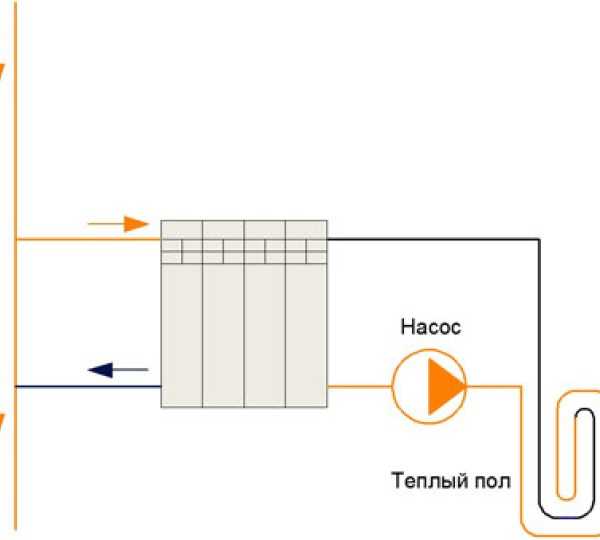

Connecting a water heated floor to a radiator Direct connection using a bypass.
Principles of operation of the heating system
This connection option is not technically difficult. A heated towel rail is a heating device installed in almost every city apartment. From a constructive point of view, this is an external element of communications through which a hot coolant or hot water of the DHW system circulates.Such elements are often installed as a compensating loop of the heating system, and play the role of an additional source of heat in rooms with high humidity. The name of the element speaks for itself, hence the serpentine shape, thanks to which the heated circuit can be effectively used.
For aesthetics, towel warmers are usually made of stainless steel or nickel-plated. The very design and method of connecting a heated towel rail to a centralized communication allow you to connect a water floor pipe to it without much difficulty. As a rule, small diameter pipes are used for underfloor heating. For a bathroom, the area of which rarely exceeds 4-5 m2 in a city apartment, only 15-20 meters of pipe will be required.
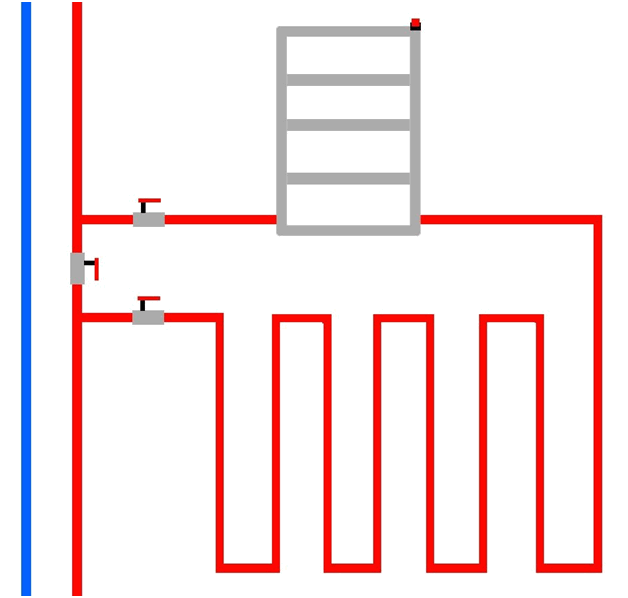

There are two types of heated towel rails:
- a coil that is connected to a centralized heating system;
- a coil that is connected to the centralized DHW.
In the first case, with the onset of the heating season, water fills the heated towel rail and, accordingly, enters the underfloor heating circuit, heating the floor surface.
The first option works only during the heating season. The rest of the time, your warm floor will be inactive. A coil connected to the DHW system looks preferable. Such a bathroom floor will always work, providing a good microclimate and a comfortable temperature.
How to legalize water heated floors in an apartment building?
Zhukovsky 289 cost of the questionquestion resolved Minimize Legal advice online Answer on the site within 15 minutes Answers of lawyers (2) received a fee of 56% 8.1 Rating Pravoved.ru 5117 answers 2521 opinion expert Chatting Free assessment of your situation
Syktyvkar Free assessment of your situation
- expert
- 8.1 rating
Hello, Vladimir, the first question that arises: vertical or horizontal wiring of the heating system in your house? Judging by the fact that you wrote that you did not have a heating system in your apartment, I can only assume that the wiring is horizontal, the heat-consuming installations in the apartments have disconnecting devices, which means they are not the common property of the owners of the premises in the house.
In this regard, the heat exchanger installed by you with the transition to underfloor heating simply acts as a radiator, and the common property is not affected in any way.
How to get permission for a warm floor in an apartment
However, if underfloor heating is installed in an apartment located in a house with insufficient electrical power, problems remain. This category includes all houses, except for new buildings.
In the old days, houses were built with a power grid designed for the minimum number of electrical appliances, and the old wiring does not withstand the use of modern appliances, including the use of an electric floor. For underfloor heating, it is necessary to replace the wiring and the distribution board.
The housing inspectorate must provide a certificate of the power of the device, confirming that the warm floor will not cause overloads in the network. Such a certificate will remove responsibility in case of any problems with the electrical network. Such a certificate must be obtained from the management company serving the house where this redevelopment is planned.
If there is not enough power, the electric floor cannot be installed.


